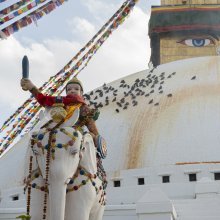Pigeon: 3 definitions
Introduction:
Pigeon means something in Hinduism, Sanskrit. If you want to know the exact meaning, history, etymology or English translation of this term then check out the descriptions on this page. Add your comment or reference to a book if you want to contribute to this summary article.
Images (photo gallery)
In Hinduism
Natyashastra (theatrics and dramaturgy)
Source: Shodhganga: Elements of Art and Architecture in the Trtiyakhanda of the Visnudharmottarapurana (natya)1) The Pigeon (colour) is denoted by the Sanskrit word Kapota and is associated with Karuṇa or the “pathetic sentiment”, which represents one of the nine kinds of Rasa (“soul of Drama”), according to the Viṣṇudharmottarapurāṇa, an ancient Sanskrit text which (being encyclopedic in nature) deals with a variety of cultural topics such as arts, architecture, music, grammar and astronomy.— Karuṇa i.e., pathos is the sentiment delineated in the circumstances of sorrow. The Viṣṇudharmottarapurāṇa says that it is enacted through frightened limbs, crying in grief, pale and dry face. [...] Śoka is the sthāyibhāva of karuṇarasa. Kapota i.e., the colour of pigeon is the colour of this sentiment. Yama is the God of this sentiment.
2) The Pigeon (in Sanskrit: Kapota) is also found in Kapotahasta: one of the thirteen Combined-hand Gestures (in Indian Dramas) (known as saṃyuktahastas).—The word kapota means pigeon in Sanskrit. When the sides of two hands are joined together it is looked like a pigeon with its wings. In the Viṣṇudharmottarapurāṇa this hand posture is called as kapotahasta and it is used to show cold and danger. But in the Abhinayadarpaṇa, this posture is said to use in salutation, addressing teachers, polite acceptance or agreement.

Natyashastra (नाट्यशास्त्र, nāṭyaśāstra) refers to both the ancient Indian tradition (shastra) of performing arts, (natya—theatrics, drama, dance, music), as well as the name of a Sanskrit work dealing with these subjects. It also teaches the rules for composing Dramatic plays (nataka), construction and performance of Theater, and Poetic works (kavya).
Vastushastra (architecture)
Source: Shodhganga: Elements of Art and Architecture in the Trtiyakhanda of the Visnudharmottarapurana (vastu)The Pigeon Color is recommended for those Stones that are used as a Material for the Construction of Temples, according to the Viṣṇudharmottarapurāṇa, an ancient Sanskrit text which (being encyclopedic in nature) deals with a variety of cultural topics such as arts, architecture, music, grammar and astronomy.—Finding of proper types of materials is one of the important aspects for any construction. Indian scriptures state that to procure the stones, the astrologer and the architect should go to mountain and examine the stones. In the Viṣṇudharmottarapurāṇa a proper examination of stone is suggested in this regard. In connection with temple building some specific colours of stones are also recommended. These are, for example the colour of the pigeon.

Vastushastra (वास्तुशास्त्र, vāstuśāstra) refers to the ancient Indian science (shastra) of architecture (vastu), dealing with topics such architecture, sculpture, town-building, fort building and various other constructions. Vastu also deals with the philosophy of the architectural relation with the cosmic universe.
Ayurveda (science of life)
Agriculture (Krishi) and Vrikshayurveda (study of Plant life)
Source: Shodhganga: Drumavichitrikarnam—Plant mutagenesis in ancient IndiaThe Pigeon is denoted by the Sanskrit term Pārāvata, whose flesh is used in a recipe for manipulating the colour of flowers or fruits (on the tree) [varṇa-pravartana], according to the Vṛkṣāyurveda by Sūrapāla (1000 CE): an encyclopedic work dealing with the study of trees and the principles of ancient Indian agriculture.—Accordingly, “The white flowers of a tree turn into a golden colour if it is smeared at the roots with the mixture of Rubia cordifolia, red lead, milk, a kind of fragrant earth and flesh of pigeon (pārāvata-āmiṣa)”.

Āyurveda (आयुर्वेद, ayurveda) is a branch of Indian science dealing with medicine, herbalism, taxology, anatomy, surgery, alchemy and related topics. Traditional practice of Āyurveda in ancient India dates back to at least the first millenium BC. Literature is commonly written in Sanskrit using various poetic metres.
See also (Relevant definitions)
Starts with: Pigeon bean, Pigeon berry, Pigeon flower, Pigeon grass, Pigeon meat, Pigeon orchid, Pigeon pea, Pigeon plum, Pigeon wings, Pigeon-weed, Pigeonberry, Pigeonberry ash, Pigeonwood.
Ends with: Pigeon meat.
Full-text (+350): Kapota, Paravata, Parapata, Kapotabha, Kalarava, Kharapriya, Kabutara, Kapotaka, Citrakantha, Agnisahaya, Haritalaka, Kokadeva, Kanthirava, Madanakakurava, Grihanashana, Ghumbarada, Kabutar, Kapotakiya, Grihakapotaka, Citragriva.
Relevant text
Search found 106 books and stories containing Pigeon; (plurals include: Pigeons). You can also click to the full overview containing English textual excerpts. Below are direct links for the most relevant articles:
Animal Kingdom (Tiryak) in Epics (by Saranya P.S)
Chapter 4.26 - The Kapota (Blue rock Pigeon) in the Epics
Chapter 2.5 - The origin of the flora and fauna in the Puranas
Parables of Rama (by Swami Rama Tirtha)
Story 213 - Two men and the pigeons < [Chapter XXXIX - God Consciousness]
Story 113 - Realizing God as Omnipresent < [Chapter XVI - Self Realization]
The Jataka tales [English], Volume 1-6 (by Robert Chalmers)
Jataka 277: Romaka-jātaka < [Book III - Tika-Nipāta]
Jataka 274: Lola-jātaka < [Book III - Tika-Nipāta]
Jataka 375: Kapota-jātaka < [Volume 3]
Mahabharata (English) (by Kisari Mohan Ganguli)
Section CXLV < [Apaddharmanusasana Parva]
Section CXXXI < [Tirtha-yatra Parva]
Section XXXII < [Anusasanika Parva]
The Gautami Mahatmya (by G. P. Bhatt)
Hitopadesha (English translation) (by Sir Edwin Arnold)
Chapter 2 - The Story of the Tiger and the Traveller < [Book One - The Winning of Friends]
Chapter 1 - The Story of the Tiger and the Traveller < [Book One - The Winning of Friends]
Related products

